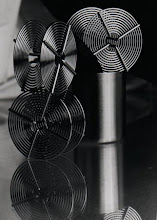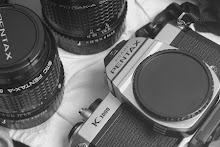

By John O'Keefe-Odom
Hydroquinone moves like a flash fire across the highlights.
When I got there, to the gallery,
I knew that one of my main ideas would involve portraying these delicate shadows cast upon the gallery walls from the track lighting. Those delicate shadows needed to be strong, contributing elements in order to hold up in the role as subjects of the photographs.
This called for severe contrast compression and long exposures.
Severe compression to get the range down to a few tones; and, long exposures in order to render those few tones as blacks and whites, not just a few soft grays.
That is, we want the tones compressed into a few forms of gray; yet, we want those grays to be distinctly different. Overall, there is a severe expansion throughout the whole contrast scheme, but within each of the available tones, there is strong compression.
A few, diverse, tones build the photos. Those tones will make the shadows their own tone, even if it is at the cost of greatly flattening and compressing the tones which show the forms of the sculpture.
Heavy blocking contrast filtration to put local colors into tonal groups to which they would not ordinarily belong; followed by long exposures to light and chemical energy to re-expand those groups into diverse tones which would still yield the subject's support (shadows on the wall) tones as middle gray.
Heavy filtration & long exposures.

It needs severe contrast compression because I knew I wanted those shadows to be a strong contributing element to the photograph. The contrast range of the sculptures themselves was much wider than the range of the shadows. The shadows had two, maybe three, tones in the gallery.
The lighting for the shadows was delicate. This called for the longer exposures to burn them in. If a more normal exposure and contrast scheme had been used, then the delicate shadows would be a delicate detail of the final photograph.

"Orbit" and its shadows.
I didn't want someone hunting for the subject. I wanted those shadows to be a part of the photo, the main part, the subject.
Why?

The sculptures are in this gallery. Those shadows on the wall are part of the sculptures' presence. It's part of they're being there. The shadows on the wall are a part of the exhibit. The shadows were specific to the exhibit and the lighting there.
If the sculptures had been photographed elsewhere, those same shadow patterns would not be there. Showing the shadows was part of showing the exhibit.
This called for a very harsh contrast and exposure pattern. Heavy filtration before camera and in printing. Hard moving developers during negative and print processing.
Almost all of the photos were made with a Green 58 filter. Bulb exposures a minute long were common. Print times, too, often came in at a minute or more.
There were two other influencing factors:

I had photographed some of the sculptures, in color, with ringlight before. This had yielded rounded, largely shadowless, color forms.
I had spent the night before baking some negatives of a test strip for six hours, and was in a flavor of falling in love with long development times. The test strips had been left standing for about six hours.
Like another roll I had done recently, the films for this session were all developed for 30 minutes, regardless of film type. This yields hard, dense negatives. It provides the compressed contrast range. In the higher speed roll (Ilford Delta 3200), it yields very strong grain.
There were a few photos in which I wanted to achieve a silhouetting effect for part of the photo, but still wanted to reveal some contours and textures of the wood.

For those, I switched over from the contrasting green filter to a CC85C, an orange filter, which would emphasize the tone of the wood by matching its local color.
Since I still wanted to achieve a strong silhouetting effect, the rest of the contrast and exposure schemes for the photos remained the same.
These pictures, too, had a lot to do with the sculptures and their environment. Again, it was a play of local lighting and shadows.
 Nails of a small Fury, its shadows, and the tone and texture of surrounding sculptures.
Nails of a small Fury, its shadows, and the tone and texture of surrounding sculptures.
Ilford Pan F+, CC85C, Bulb exposure.

Nails of the small Fury and The Shield.
Pan F+ 32 ASA, CC85C as orange contrast filter,
allowance for drop in exposure as tungsten for film
sensitivity to non-daylight exposures (even in black and white); bulb exposure of one minute.
# # #
References:
John McLeod's exhibit, "Point of Departure" at Covenant College.






No comments:
Post a Comment